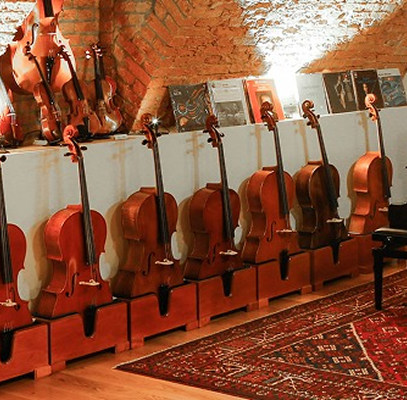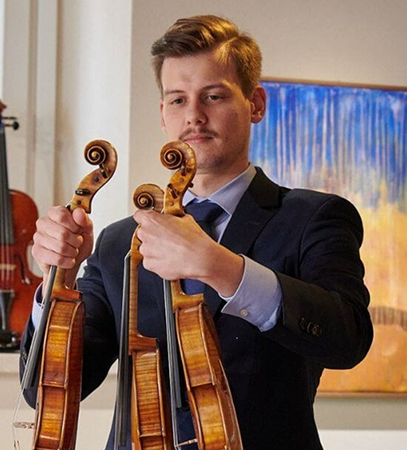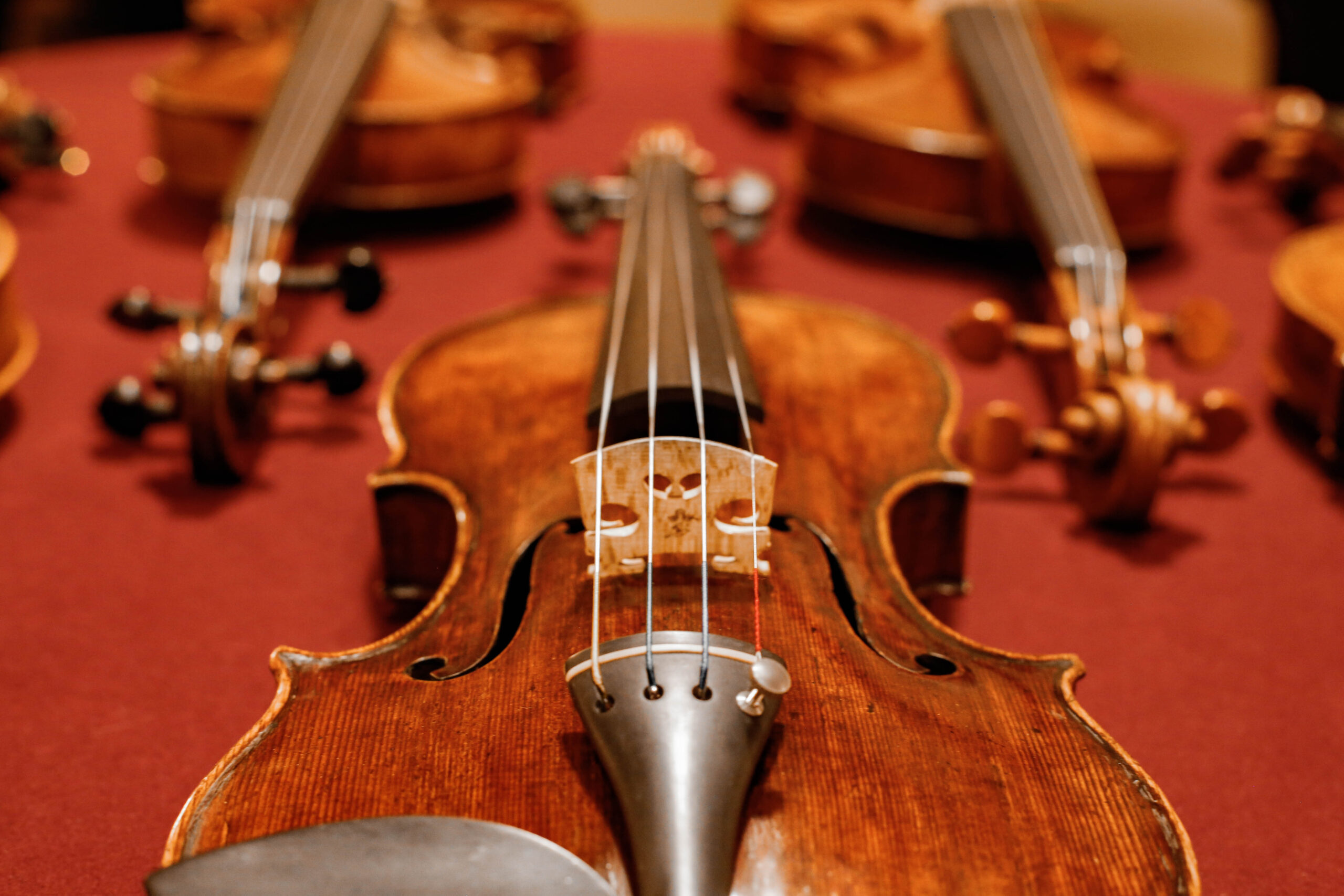
The Artist
GIUSEPPE GIBBONI
With impeccable technique and engaging expressiveness, Giuseppe Gibboni won over the jury and the public of the 56th Edition of the “Premio Paganini” International Violin Competition in Genoa in October 2021. Giuseppe Gibboni – born in 2001 – was the first violinist to bring the Paganini Prize back to Italy after 24 years. On this occasion, he also won the public prize and two special prizes for the best interpretation of Capricci and the Concerto for violin by Niccolò Paganini.
Subsequently, the now twenty-two-year-old musician began an extensive concert career. Among other things, he made his debut with the Tchaikovsky Violin Concerto with the Orchestra of the Accademia Nazionale di Santa Cecilia under the direction of Lorenzo Viotti. Shortly afterward, he played with guitarist Carlotta Dalia at the invitation of the President of the Republic, Sergio Mattarella, in the Quirinale Palace in Rome; the concert was broadcast live on Italian radio.
Among the most significant moments of last season were the debut of the Orchestra del Maggio Musicale Fiorentino conducted by Zubin Mehta in Florence, in the United States with the Detroit Symphony Orchestra conducted by Jader Bignamini and with the Orchestra del Teatro San Carlo of Naples conducted by Dan Ettinger. He performed Wynton Marsalis’ Violin Concerto with the RAI National Symphony Orchestra conducted by John Axelrod and Vivaldi’s Four Seasons with the Sinfonietta Riga in Latvia. He regularly performs in recitals throughout Italy, including at the Amici della Musica in Florence, at the Serate Musciali in Milan, at the Teatro Petruzzelli in Bari, and at the Stresa Festival.
In the autumn of 2023, Gibboni was a guest of the Milan Symphony Orchestra conducted by Joel Sandelson for the first time, where he performed Tchaikovsky’s Violin Concerto. In addition to numerous appearances in Italy, he can also be heard in the series “Debüt im Nikolaisaal” in Potsdam and at the Heidelberger Frühling in the current season.
Born and raised in a family of musicians, Giuseppe Gibboni was educated by his father, Daniele Gibboni, before attending the “G. Martucci” of Salerno. At the age of 14, he was admitted to the Stauffer Academy in Cremona, where he received lessons from Salvatore Accardo. He successfully graduated from the Accademia Chigiana in Siena. After a five-year specialization course at the Perosi Academy in Biella with Pavel Berman, he studied at the Mozarteum University in Salzburg with Pierre Amoyal.
Gibboni became known to the general television audience in 2016 thanks to his success in the Prodigi – La musica è vita competition broadcast by RAI 1. In the same year, he won the first prize and a special prize at the Andrea Postacchini Violin Competition, followed by successes at the International Competition Leonid Kogan in Brussels (2017), at the George Enescu International Competition in Bucharest (2018), and at the Valsesia Musica Competition (2020).
He recorded his debut CD at the age of 15 for the Warner Classics label. As the winner of the Paganini Competition, he also had the opportunity to play on the “Cannone”, Niccolò Paganini’s favorite instrument built by Guarneri del Gesù in 1743.
The Violin
1734 ANTONIO STRADIVARI ‘LAM, EX-SCOTLAND UNIVERSITY’, CREMONA
This exceptional-sounding and looking instrument was crafted in the final years of Stradivari’s life, at the peak of his maturity, exhibiting his best attributes and strongest character. The f-holes are slightly tilted, elegantly crossing the generous curve of the central arching of the top and showing perhaps the hand of his son Francesco as well. The strong and perfectly round-shaped edges frame the whole body of the violin, giving special glamour to the instrument’s attractive broad curls of its single-piece back, cradling within itself all the beauty of the traditional Stradivarian strong golden ground color and red-brown varnish of silky, yet translucent, texture.
The back is made of quarter-cut maple, and the arching extends fully to the edges, adding to this masterpiece’s strong personality. An original wing was added to the lower treble flank. The ribs are crafted from wood similar to the back, while the head, also maple, has a different grain. The two-piece belly is made of spruce, finely grained at the center and widening towards the flanks.
The name “Scotland University” originates from one of its previous owners, Mr. George D. N. Neill of Drumlea, Greenock, in Scotland’s West-Central Lowlands, who bequeathed it to a Scottish university. In the late 19th century, the violin was acquired by an English amateur player named Heath, who sold it to Hill in London in 1873. They subsequently found Mr. G. D. N. Neill. Neill left instructions in his will to have the instrument and several others handed down to the university, which later sold the instruments to fund a scholarship.
In 1948, renowned New York violinist Frank Gullino purchased the instrument from Hills. Between 1963 and 1968, the violin passed through the Rembert Wurlitzer shop multiple times. In June 1972, the ‘Scotland University’ was acquired by Chinese entrepreneur, amateur violinist and patron of the arts, Sau-Wing Lam, and is now part of the prestigious Sau-Wing Lam Collection.
Since 2023, the violin has been the faithful companion of Giuseppe Gibboni, on loan through Classically Connected, Inc.
Discover More About This Violin

The Bow
VIOLIN BOW BY F.X.TOURTE, PARIC c.1800-1810
The bow displays the great sober and functional qualities of the maker’s innovative approach. The unique combination of weight and frog-to-tip balance is legendary among players.
François Tourte (1747-1835) is revered as the foremost figure in the history of bow-making. His innovations revolutionized the design of the modern bow. While many of the elements he improved existed before him, Tourte’s genius lay in integrating them into a cohesive and distinctly different instrument. Beginning his career alongside his brother Nicolas Leonard, Tourte soon emerged as an independent force in bow-making. From the late 1780s to the 1830s, he developed unique models that set his work apart. His craftsmanship became the benchmark for modern design, influencing bow makers for generations.
Today, Tourte’s designs from the early 19th century remain highly regarded and serve as inspiration for contemporary bow makers. His legacy is one of unparalleled innovation and craftsmanship, shaping the course of bow-making history.
Artist Centric Model
Discover more about the investment opportunity. By joining our Artist-Centric Investment Program, you're investing in the future of music, supporting artists' careers, and owning a piece of history.





